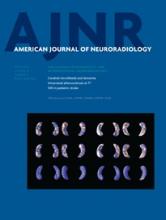Abstract
BACKGROUND AND PURPOSE: Flow-diverter technology has proved to be a safe and effective treatment for intracranial aneurysm based on the concept of flow diversion allowing parent artery and collateral preservation and aneurysm healing. We investigated the patency of covered side branches and flow modification within the parent artery following placement of the Pipeline Embolization Device in the treatment of intracranial aneurysms.
MATERIALS AND METHODS: Sixty-six aneurysms in 59 patients were treated with 96 Pipeline Embolization Devices. We retrospectively reviewed imaging and clinical results during the postoperative period at 6 and 12 months to assess flow modification through the parent artery and side branches. Reperfusion syndrome was assessed by MR imaging and clinical evaluation.
RESULTS: Slow flow was observed in 13 of 68 (19.1%) side branches covered by the Pipeline Embolization Device. It was reported in all cases of anterior cerebral artery coverage, in 3/5 cases of M2-MCA coverage, and in 5/34 (14.7%) cases of ophthalmic artery coverage. One territorial infarction was observed in a case of M2-MCA coverage, without arterial occlusion. One case of deep Sylvian infarct was reported in a case of coverage of MCA perforators. Two ophthalmic arteries (5.9%) were occluded, and 11 side branches (16.2%) were narrowed at 12 months' follow-up; patients remained asymptomatic. Parent vessel flow modification was responsible for 2 cases (3.4%) of reperfusion syndrome. Overall permanent morbidity and mortality rates were 5.2% and 6.9%, respectively. We did not report any permanent deficit or death in case of slow flow observed within side branches.
CONCLUSIONS: After Pipeline Embolization Device placement, reperfusion syndrome was observed in 3.4%, and territorial infarction, in 3.4%. Delayed occlusion of ophthalmic arteries and delayed narrowing of arteries covered by the Pipeline Embolization Device were observed in 5.9% and 16.2%, respectively. No permanent morbidity or death was related to side branch coverage at midterm follow-up.
ABBREVIATIONS:
- ACA
- anterior cerebral artery
- PED
- Pipeline Embolization Device
- © 2015 by American Journal of Neuroradiology












